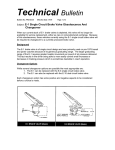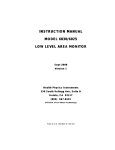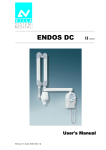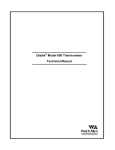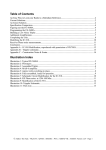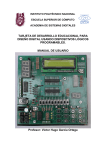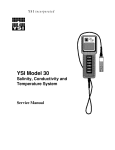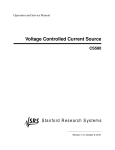Download User Manual - Far West Technology, Inc.
Transcript
INSTRUCTION MANUAL MODEL 6031 ION CHAMBER PULSE LINK AREA MONITOR March 1998 Version 2A Health Physics Instruments 330 South Kellogg Ave, Suite D Goleta, CA 93117 (805) 967967- 8422 Division of Far West Technology MODEL 6031 INSTRUCTION MANUAL PAGE 1 ION CHAMBER AREA MONITOR INSTRUMENTS HEALTH PHYSICS INTRODUCTION The model 6031 is an ion chamber area monitor. It is designed to be powered by an HPI Pulse link Receiver. The 6031 produces a calibrated pulse output. The instrument will operate over a wide range of doserates and a wide range of energies. II. DESCRIPTION AND CONTROLS The model 6031 has all of the controls and connections on one side (see Figure 1). These include: Digital Counter: This is a 6 digit up counter that counts up with every pulse that is transmitted on the Pulse Link. Counter Reset: Reset for the Digital Counter. Pulse Link Connection: This is a BNC connector that should be connected to the input to a Pulse Link Receiver through coax. Both power and data are transmitted on this connection. Accessory Connector: This connector contains signals for testing the instrument. The connections are detailed below. III. INSTALLATION The model 6031 is installed by plugging it into a Pulse Link Receiver. The BNC on the panel of the 6031 should be mated to the input on the Pulse Link Receiver through a patch cord with a BNC on each end. The counter should be reset after turn on to make it count properly. IV. OPERATION The instrument will produce a pulse rate proportional to the radiation level. 1 mR/h equals .25 Hz and 1 R/h equals 250 Hz. The instrument will need about 1 minute after turn-on to be operational. Right after turn on there is about a 10 second delay. Then the instrument produces many pulses per second, tapering off to the radiation field. This is the high voltage stabilizing. It gives you an indication that the instrument is functioning. MODEL 6031 INSTRUCTION MANUAL PAGE 2 ION CHAMBER AREA MONITOR INSTRUMENTS HEALTH PHYSICS The outer equilibrium wall can be removed for low energy operation. The inner wall is made of styrofoam and is easily damaged. The sticker on the front indicates the front of the wall Figure 1 Location of Controls V. ACCESSORY CONNECTION CONNECTION The accessory connection allows the instrument to be operated without the Pulse Link. Some of the signals are available from this connector. The pin definitions are: PIN # DESCRIPTION K Output pulse L Ground M External power N +5 VDC output Connector type: Cannon KPT, 15 pin. Part Number KPT06J14-15P PIN FUNCTIONS AND DESCRIPTIONS: Output pulse: This is an LSTTL positive going output pulse for each discriminated event. This is not a buffered signal, however it will drive 1 LSTTL load. Ground: Signal and power ground. This is the negative input for external power. MODEL 6031 INSTRUCTION MANUAL PAGE 3 ION CHAMBER AREA MONITOR INSTRUMENTS HEALTH PHYSICS External Power: This is the positive input for external power. It can power the instrument instead of or with the Pulse Link. The external power should be above 9 volts. The instrument can be powered continuously by connecting external power to this input before removing the Pulse Link connection. +5 VDC Output: This is an output of 5 volts. This is the positive connection. The ground pin is the negative connection. VI. CONSTRUCTION The electronics is all housed inside the cast aluminum case. The case is gasketed and sealed. To gain access to the circuit boards, remove the four screws on the bottom of the case. These screws are captive. The large circuit board is held in place with 4 screws around the edge. To remove the board it is necessary to unsolder the high voltage lead and unscrew the electrometer connection. The high voltage lead is located in the high voltage section near the electrometer cover. The electrometer cover is located in the center of the circuit board. Remove the four screws holding the cover. Remove the 4-40 nut/spacer that holds the lug to the center electrode. Disconnect the cables from the board and the board is free to be lifted from the box. Before removing the circuit board, it is a good idea to short the high voltage to ground to keep from destroying any part of the instrument by getting your hand between high voltage and any component. The desiccant is mounted in the lid. Make sure that it is replaced or baked out for 3 hours at 300°F if it is pink. It can also be put in a vacuum oven to remove the moisture. All controls, screws and openings are treated with RTV silicone sealant to keep the box from breathing with atmospheric pressure changes. VII. CALIBRATION If the instrument is new, perform all the adjustments described in the adjustment section. Expose the instrument to about 100 mR/h. Adjust R37 until the output frequency reads 25.0 Hz. To adjust R37 it is necessary to remove the screw on the outside of the case and use a long screwdriver to adjust the control. Replace the screw and nylon washer to maintain the integrity of the case. It may be necessary to remove the cover the first time the control is adjusted to learn where to move the screwdriver. The instrument can be calibrated with the cover removed. It is a good idea when calibrating the instrument to check the desiccant. The desiccant is mounted in the lid. Make sure that it is replaced or baked out for 3 hours at 300 °F if it is pink. It can also be put in a vacuum oven to remove the moisture. VIII. INTERNAL ADJUST ADJUSTMENTS MENTS AND CONTROLS A. ADJUSTMENTS The calibration, high voltage, lower threshold, upper threshold, and reset pulse height are all located on the circuit board. They are adjusted as follows: NOTE: There is a testpoint for ground TPGND located near the 3 terminal regulators. MODEL 6031 INSTRUCTION MANUAL PAGE 4 ION CHAMBER AREA MONITOR INSTRUMENTS HEALTH PHYSICS High Voltage Connect a high voltage voltmeter probe (>10000 Meg) between TP10 (+ lead) and ground (- lead). Adjust R75 until the voltmeter reads 700 volts. Lower Threshold Connect a voltmeter between ground (- lead) and pin 7 of U1, an LP339 (+lead). Adjust R37 until the voltmeter reads 0.1 volts. To adjust R37 it is necessary to remove the screw on the outside of the case and use a long screwdriver to reach the control. Replace the screw and nylon washer to maintain the integrity of the case. Upper Threshold Connect a voltmeter between ground (- lead) and pin 9 of U1, an LP339 (+lead). Adjust R48 until the voltmeter reads 0.5 volts. Reset Pulse Height Method 1 Connect the positive lead of a 0.05 volt negative power supply to the chassis of the 6031. Hook the negative lead to the center terminal of the ion chamber inside of the small electrometer box on the circuit board. Connect an oscilloscope between ground and the testpoint TP3. Set the oscilloscope on 0.2 V/cm and 10 ms sweep speed. Turn R62 20 turns counter-clockwise or until it clicks. Slowly turn it clockwise. At some point you should see a ramp.. Adjust R62 until the negative portion of the ramp is at .1 volt. The ramp should start at .1 volts and go to .5 volts. If you turn it too far, there will be large negative or positive excursions. Reset Pulse Height Method 2 This method should be used as a last resort. It is much touchier and not as easy to set as method 1. Connect a clip lead from TP 15 to one side of a 1K ohm resistor. With the other side of the resistor touch pin 18 of U3, the 24 pin IC. Push the reset button and wait 2 seconds then remove the resistor. This puts the instrument in a special mode where it will continually reset itself. Connect an oscilloscope between ground and the testpoint TP3. Set the oscilloscope on 0.2 V/cm and 10 ms sweep speed. You should see a negative ramp. Adjust R62 until the period of the ramp is 50 ms. The instrument will also ramp at turn on. This allows you to check the reset pulse height setting without connecting the clip lead. Just turn the instrument on and look at TP3. If you do it by turning on the power, you will also have a rising high voltage and this will effect the reading. If, however you wait a minute or so for high voltage to stabilize, then push the reset button on the circuit board (S1) then the microprocessor will initiate a turn on and ramp the system. You only have a few seconds to watch the signal, but you can reset it as many times as you need. Incidentally there is a delay of a few seconds from the time you push the reset button until the ramp begins. CHECKING THE RANGE OF THE DAC You can also check the DAC at turn on. It ramps up from ground. The signal can be found by looking with an oscilloscope at pin 3 of U5. The buffered signal is on pin 1, and an inverted signal is on pin 7. The buffered signal will not go fully positive, and the inverted signal will not go fully negative. MODEL 6031 INSTRUCTION MANUAL PAGE 5 ION CHAMBER AREA MONITOR INSTRUMENTS HEALTH PHYSICS B. CONTROLS The only control is the reset button located on one end of the board. Pushing it will reset the microprocessor and has the same effect as turning power off and back on. IX. THEORY OF OPERATION OPERATION The instrument measures the current from the detector with an integrator. The integrator is reset when its output goes past a threshold. Figure 2 shows a simplified schematic of the instrument. The ion chamber produces a positive current at the inverting input of the electrometer. The electrometer is an integrator with a 1 pF feedback capacitor, C3. The output of the electrometer ramps negatively from the ion chamber current. When the electrometer output reaches zero volts, or ground, the output of U2, a comparator, changes state. This signals the microprocessor to turn on S1 for a few microseconds. The voltage from the DAC, which is negative, is transferred through C2 and D1 to the input of the electrometer and causes the output of the electrometer to swing positively. This cycle repeats as long as there is current from the detector. After each current pulse, the microprocessor looks at the state of the second comparator, U3. If the charge pulse was large enough to trip U3, then the microprocessor, through the DAC reduces the size of the charge pulse. If the comparator did not trip, then the microprocessor increases the output of the DAC. Thus the output of the DAC is constantly changing up and down by 1 bit to keep the reset pulse at the 0.1 volt reference level. If the ion chamber has no input and the leakage currents make the output of the electrometer go positive rather than negative, then eventually U4 would trip when the output of the electrometer reached 0.5 volt. At this point the microprocessor pulses S2. This injects current into the electrometer causing the output to go negative. The microprocessor stops the pulses when U3 trips indicating the output of U1 has dropped to the 0.1 volt level. Figure 2 Block Diagram MODEL 6031 INSTRUCTION MANUAL PAGE 6 ION CHAMBER AREA MONITOR INSTRUMENTS HEALTH PHYSICS When the instrument is first turned on the system ramps up and down using S1 and S2 to set the DAC so that the current pulse is of the correct magnitude. The Calibration control changes the level of the 0.1 volt reference and then directly changes the charge per pulse. 0.1 volt with 1 pF feedback capacitor is 0.1 picocoulombs or 0.1 picoamp for a pulse per second. The leakage currents are about 1 pulse every minute or about 2 femtoamps. C1 and R1 form an RC network to smooth out pulsed radiation. X. CIRCUITRY Many of the components on the schematic are not used in this model. The ion chamber generates a positive current. The RC filter R22 and C6 are used to filter out fast peaks and smooth the signal going into the digitizer. U2 is a high impedance electrometer/op-amp that has only a 1 pF feedback capacitor and functions as an integrator. The output divider R2 and R14 are not used, instead R14 is shorted. The output of the electrometer goes to four comparators (U1). The first U1:A compares the signal to ground. The second, U1:B compares it to .1 volt. The third, U1:C compares it to .5 volt. The last one U1:D is not used in this application. The output of the comparators are buffered to keep their outputs positive and then they go to the microprocessor U3. This is a single chip RISC micro. The program is only about 100 bytes long. The microprocessor takes two actions. The first is to generate a charge pulse to offset the input current. It uses the information from the first comparator, U1:A for this. When the output of the electrometer goes below ground U1:A goes from high to low and the microprocessor generates a charge pulse by pulsing pin 6 (high-low-high). This causes the switch U4:B to turn on and off generating the pulse through Q2. The size of the current pulse is set by the DAC. The height of the current pulse is determined by the voltage at the output of the DAC buffer U5 and by the DAC ladder network, R6 to R42. The microprocessor looks at the height of the pulse by way of the second comparator, U1:B. If U1 has tripped, then it adjusts the DAC up. If U1 has not tripped, the DAC is decreased. In this way the system oscillates around the voltage set by R37 which is around .1 volts. The adjustment, U48 is also modified by the output pulse from pin 14 of the microprocessor. This decreases the voltage across R37 to make up for losses at high counting rates. If Comparator U1:C trips, it indicates that the input is leaking and the output of the electrometer is going positive. The microprocessor takes action to keep the integrator from going too positive by pulsing the switch U4:A (TP9). This signal injects a current into the input through Q1 that causes the electrometer to go negative. When it reaches the level of the second comparator U1:B of .1 volt it stops. The Buffer U5 inverts the output of the ladder network (R6 to R42) to go negative. The High voltage is generated by the high voltage power supply. The high voltage is set at 700 Volts. U6:A is a square wave oscillator. It continually generates a square wave on pin 5. The other half of U6 is a oneshot that is resetable through comparator U7. The comparator measures the high voltage through the voltage divider consisting of R72 and R74. If the high voltage is too low, the comparator will turn on the one shot. The output of the one shot turns on Q3 and generates a pulse on T1. The output of T1 which is a step up transformer, is stepped up through the trippler consisting of D9,10, & 11 and C16,23 & 19. RA1 and C26 provide feed forward to speed up the turn off of the comparator. U7:B is a buffer. The filter R65,,R66, C20, C21 and C22 reduce the high voltage ripple. The low voltage power supply consists of U13 and U14, both 3 terminal 5 volt voltage regulators. The negative voltage is generated by U8. The references U10 and U9 are not used. The Pulse Link signal is generated by the microprocessor U3 pin 14 whenever it generates a charge pulse. This signal is shortened by the one-shot U12:A and fed to Q4 where is creates the current pulse on the Pulse Link line. L1 isolates the power supplies from the Pulse Link signal. The counter U11 counts the pulses for direct viewing. MODEL 6031 INSTRUCTION MANUAL PAGE 7 ION CHAMBER AREA MONITOR INSTRUMENTS HEALTH PHYSICS JUMPER SETTINGS The jumpers are set as follows: JP1 1 Meg 1% resistor from pin 2 to pin 1 of U12. Mounted on bottom of PCB JP2 Jumper pin 1 and 2 JP3 Jumper pin 1 and 2 JP4 Jumper pin 1 and 2 JP5 No jumper JP6 Jumper pin 1 and 2 JP7 Jumper pin 1 and 2 JP8 Jumper pin 1 and 2 JP9 Jumper pin 1 and 2 JP11 No jumper MODEL 6031 INSTRUCTION MANUAL PAGE 8 ION CHAMBER AREA MONITOR INSTRUMENTS HEALTH PHYSICS .6031 PARTS LIST DESIGN QUAN PART NO ------ ----- -------------------C01 1 C02 1 C03 1 C05 1 C06 1 C07 1 C08 1 C09 1 C10 1 C11 1 C12 1 C13 1 C14 1 C15 1 C16 1 C17 1 C19 1 C20 1 C21 1 C22 1 C23 1 C24 1 C25 1 C26 1 C27 1 C28 1 C29 1 C30 1 C31 1 C32 1 C33 1 C34 1 C35 1 C36 1 C37 1 C38 1 C39 1 C40 1 C41 1 C42 1 C43 1 CA1 1 CX1 1 D1 1 D10 1 FR107 D11 1 FR107 D13 1 1N4004 D2 1 D3 1 D4 1 D5 1 D6 1 D7 1 D9 1 FR107 L1 1 P1 1 P2 1 P3 1 P4 1 P5 1 Q1 1 2N4117A Q2 1 2N4117A Q3 1 VN10KM Q4 1 2N2222 R04 1 R05 1 R06 1 R07 1 R08 1 R09 1 R10 1 R11 1 R12 1 R13 1 R15 1 R17 1 TYPE -------------------1 PF 15 PF 15 PF 0.1 UF 100 PF 100 PF 0.1 UF 0.1 UF 10 PF 5% 10 PF 5% 0.1 UF 10 UF 0.1 UF 0.1 UF 0.0022 UF 3KV 47 UF 0.01 UF 3KV 0.01 UF 3KV 0.01 UF 3KV 0.05 UF 3KV 0.0022 UF 3KV 0.001 UF 100 PF 0.001 UF 0.1 UF 0.1 UF 0.1 UF 47 UF 47 UF 10 UF 470 PF 0.1 UF 0.1 UF 0.1 UF 0.1 UF 0.1 UF 0.1 UF 0.1 UF 330 UF 33 UF 33 UF 100 PF 3KV 0.047 UF 1N4148 1 KV FAST RECOVERY 1 KV FAST RECOVERY 1N4148 1N4148 1N4148 1N4148 1N4148 1N4148 1 KV FAST RECOVERY 10 MH SIP X 6 SIP X 6 SIP X 2 SIP X 14 SIP X 2 POWER NPN 10 K 10 K 100.0K 49.9K 10 100 K 100.0K 49.9K 100.0K 49.9K 1 M 100.0K DESCRIPTION -------------------CAPACITOR, TEFLON CAPACITOR CERAM MONO CAPACITOR CERAM MONO CAPACITOR CERAM MONO CAPACITOR CERAM MONO CAPACITOR CERAM MONO CAPACITOR CERAM MONO CAPACITOR CERAM MONO CAPACITOR CERAM MONO CAPACITOR CERAM MONO CAPACITOR CERAM MONO CAPACITOR TANTALUM CAPACITOR CERAM MONO CAPACITOR CERAM MONO CAPACITOR CERAM DISC CAPACITOR TANTALUM CAPACITOR CERAM DISC CAPACITOR CERAM DISC CAPACITOR CERAM DISC CAPACITOR CERAM DISC CAPACITOR CERAM DISC CAPACITOR CERAM MONO CAPACITOR CERAM MONO CAPACITOR CERAM MONO CAPACITOR CERAM MONO CAPACITOR CERAM MONO CAPACITOR CERAM MONO CAPACITOR TANTALUM CAPACITOR TANTALUM CAPACITOR TANTALUM CAPACITOR CERAM MONO CAPACITOR CERAM MONO CAPACITOR CERAM MONO CAPACITOR CERAM MONO CAPACITOR CERAM MONO CAPACITOR CERAM MONO CAPACITOR CERAM MONO CAPACITOR CERAM MONO CAPACITOR ELECTRO CAPACITOR TANTALUM CAPACITOR TANTALUM CAPACITOR CERAM DISC CAPACITOR CERAM MONO DIODE DIODE DIODE DIODE DIODE DIODE DIODE DIODE DIODE DIODE DIODE CHOKE HEADER HEADER HEADER HEADER HEADER FET FET FET, N CHAN TRANSISTOR RESISTOR 5% CF RESISTOR 5% CF RESISTOR 1% MF RESISTOR 1% MF RESISTOR 5% CF RESISTOR 5% CF RESISTOR 1% MF RESISTOR 1% MF RESISTOR 1% MF RESISTOR 1% MF RESISTOR 5% CF RESISTOR 1% MF MFG SUPPLIER DRAWING # ---------- ---------- --------HPI 6031-001 6031-001 6031-001 6031-001 6031-001 6031-001 6031-001 6031-001 6031-001 6031-001 6031-001 6031-001 6031-001 6031-001 6031-001 6031-001 6031-001 6031-001 6031-001 6031-001 6031-001 6031-001 6031-001 6031-001 6031-001 6031-001 6031-001 6031-001 6031-001 6031-001 6031-001 6031-001 6031-001 6031-001 6031-001 6031-001 6031-001 6031-001 6031-001 6031-001 6031-001 6031-001 6031-001 6031-001 6031-001 6031-001 6031-001 6031-001 6031-001 6031-001 6031-001 6031-001 6031-001 6031-001 6031-001 MOLES 6031-001 MOLES 6031-001 MOLEX 6031-001 MOLEX 6031-001 MOLEX 6031-001 6031-001 6031-001 SILICONIX 6031-001 6031-001 6031-001 6031-001 6031-001 6031-001 6031-001 6031-001 6031-001 6031-001 6031-001 6031-001 6031-001 6031-001 DESIGN QUAN PART NO TYPE DESCRIPTION MFG SUPPLIER DRAWING # ------ ----- -------------------- -------------------- -------------------- ---------- ---------- --------R18 R19 1 1 49.9K 10 K RESISTOR 1% MF RESISTOR 5% CF 6031-001 6031-001 MODEL 6031 INSTRUCTION MANUAL PAGE 9 ION CHAMBER AREA MONITOR INSTRUMENTS R20 R21 R22 R23 R24 R25 R26 R27 R28 R29 R31 R32 R35 R36 R37 R38 R39 R40 R41 R42 R44 R47 R48 R50 R51 R53 R54 R55 R56 R57 R58 R59 R62 R63 R64 R65 R66 R67 R68 R69 R70 R70 R72 R74 R75 R76 R77 R79 R80 R81 R82 R84 RA1 RX2 S1 S2 T1 U1 U11 U12 U13 U14 U2 U3 U4 U5 U6 U7 U8 X1 1 1 1 1 1 1 1 1 1 1 1 1 1 1 1 1 1 1 1 1 1 1 1 1 1 1 1 1 1 1 1 1 1 1 1 1 1 1 1 1 1 1 1 1 1 1 1 1 1 1 1 1 1 1 1 1 1 1 1 1 1 1 1 1 1 1 1 1 1 1 MPE-106F LP339N SUB1000 74LS221 LM2931-5.0 LM2931-5.0 LMC6041A1N PIC16C55 CD4053BE TLC27M2 ICL7556 TLC27L2 ICL7660 100.0K 49.9K 1 K M 10 K 100.0K 49.9K 10 K 100.0K 49.9K 100 K 100.0K 100.0K 100.0K 49.9K 100 K 10 100.0K 49.9K 100.0K 49.9K 10 K 100 K 100 K 100 K 10 K 100 K 10 10 K 0 10 K 10 K 10 100 K 100 10 M 10 M 1 K M 510 K 510 K 2.7 K 1 K 0 200 M 499 K 100 K 2 K 2 K 2.4 M 2.7 K 2.7 K 2.7 K 51 100 K 1 M SPST SPDT, SEALED BLOCKING QUAD 6 DIGIT DUAL 3 TERMINAL 3 TERMINAL SINGLE DUAL DUAL DUAL 8.0 MHZ HEALTH PHYSICS RESISTOR 1% MF RESISTOR 1% MF RESISTOR 5% CF RESISTOR 5% CF RESISTOR 1% MF RESISTOR 1% MF RESISTOR 5% CF RESISTOR 1% MF RESISTOR 1% MF RESISTOR 5% CF RESISTOR 1% MF RESISTOR 1% MF RESISTOR 1% MF RESISTOR 1% MF TRIMMER 3/8" SIDE RESISTOR 5% CF RESISTOR 1% MF RESISTOR 1% MF RESISTOR 1% MF RESISTOR 1% MF RESISTOR 5% CF RESISTOR 5% CF TRIMMER 3/8" TOP RESISTOR 5% CF RESISTOR 5% CF RESISTOR 5% CF RESISTOR 5% CF RESISTOR 5% CF TRIMMER 3/8" TOP RESISTOR 5% CF RESISTOR 5% CF RESISTOR 5% CF TRIMMER 3/8" TOP RESISTOR 5% CF RESISTOR 5% CF RESISTOR 5% CF RESISTOR 5% CF RESISTOR 5% CF RESISTOR 5% CF RESISTOR 5% CF RESISTOR 5% CF RESISTOR 5% CF RESISTOR 5% CF RESISTOR 1% MF TRIMMER 3/8" TOP RESISTOR 5% CF RESISTOR 5% CF RESISTOR 5% CF RESISTOR 5% CF RESISTOR 5% CF RESISTOR 5% CF RESISTOR 5% CF RESISTOR 5% CF RESISTOR 5% CF SWITCH, PUSHBUTTON SWITCH, PUSHBUTTON TRANSFORMER COMPARATOR COUNTER/DISPLAY MULTIVIBRATOR VOLT REGULATOR VOLT REGULATOR OP AMP MICROPROCESSOR SWITCH, CMOS OP AMP TIMER OP AMP VOLT CONVERTER CRYSTAL ALCO HPI NATIONAL RED LION C NATIONAL NATIONAL NATIONAL MICROCHIP TEXAS INST TEXAS INST 6031-001 6031-001 6031-001 6031-001 6031-001 6031-001 6031-001 6031-001 6031-001 6031-001 6031-001 6031-001 6031-001 6031-001 6031-001 6031-001 6031-001 6031-001 6031-001 6031-001 6031-001 6031-001 6031-001 6031-001 6031-001 6031-001 6031-001 6031-001 6031-001 6031-001 6031-001 6031-001 6031-001 6031-001 6031-001 6031-001 6031-001 6031-001 6031-001 6031-001 6031-001 6031-001 6031-001 6031-001 6031-001 6031-001 6031-001 6031-001 6031-001 6031-001 6031-001 6031-001 6031-001 6031-001 6031-001 6031-001 6031-001 6031-001 6031-001 6031-001 6031-001 6031-001 6031-001 6031-001 6031-001 6031-001 6031-001 6031-001 6031-001 6031-001 MODEL 6031 INSTRUCTION MANUAL PAGE 10 ION CHAMBER AREA MONITOR INSTRUMENTS HEALTH PHYSICS MODEL 6031 INSTRUCTION MANUAL PAGE 11 ION CHAMBER AREA MONITOR INSTRUMENTS HEALTH PHYSICS MODEL 6031 INSTRUCTION MANUAL PAGE 12 ION CHAMBER AREA MONITOR INSTRUMENTS HEALTH PHYSICS MODEL 6031 INSTRUCTION MANUAL PAGE 13 ION CHAMBER AREA MONITOR INSTRUMENTS HEALTH PHYSICS














